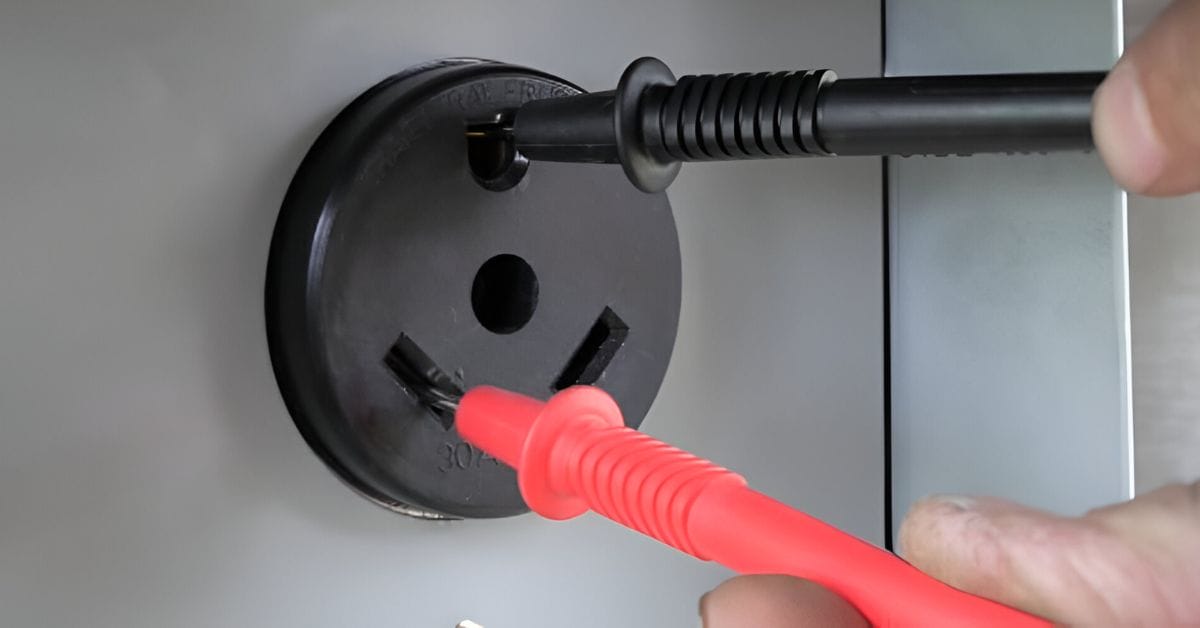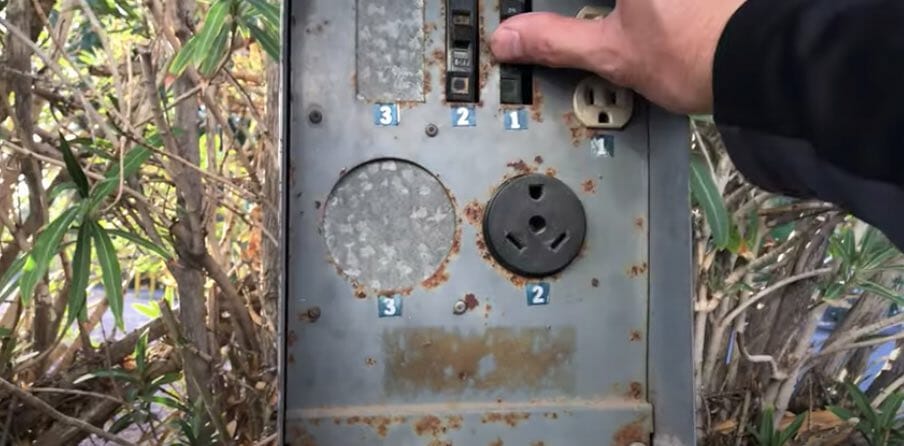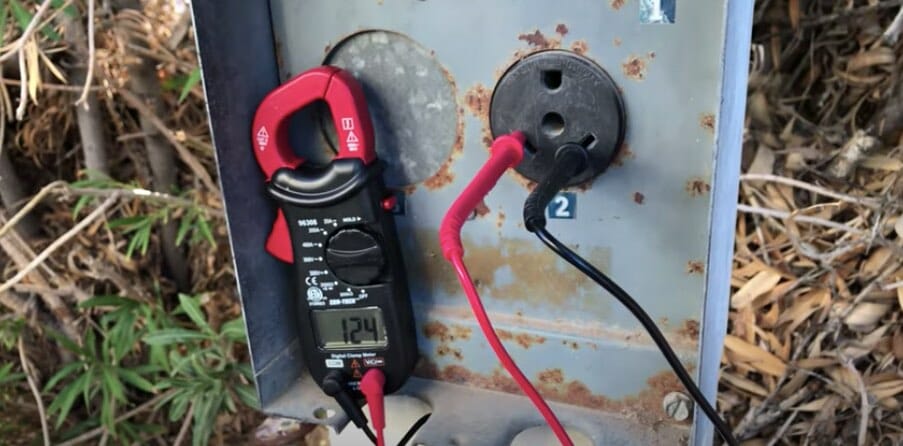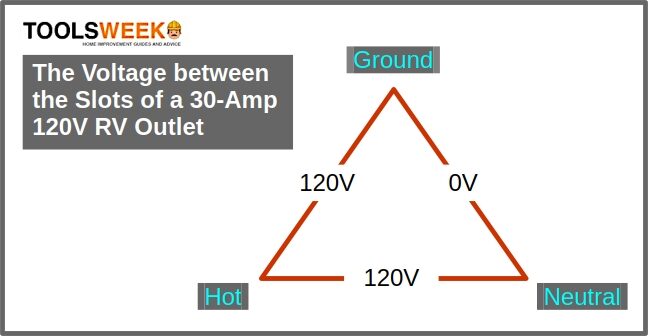How to Test 30 Amp RV Outlet with Multimeter (Guide)

You should regularly test your RV outlets, especially before a long trip.
If you’re unsure how to do it, this guide is for you.
Quick Summary: To test a 30-amp RV outlet with a multimeter:
- Set the multimeter to measure AC voltages, covering the range up to 120 volts.
- Insert the black probe into the half-round (ground) slot and the red probe into the left rectangular (hot) slot while the circuit breaker is on.
- The multimeter reading should be around 110 to 120 volts.
- Keep the black probe inside the ground slot and transfer the red probe to the common slot.
- The multimeter should give the same reading.
In this guide, I will show you how to test a 30-amp RV outlet with a multimeter, including 2-pole outlets, voltage drop testing, and more thorough tests for troubleshooting.
30-Amp RV Outlets

A 30-amp RV outlet is a 120-volt outlet for 3-prong plugs that provides electricity through a wire on a circuit connected to a 30-amp breaker.
It has 3 slots for the 3 prongs, one semi-circular one for the ground connection, and 2 rectangular ones for the hot, i.e., current-carrying, wires. The one on the left (from the viewer’s point of view) is the hot one, and the one on the right is neutral.
The 30-amp capacity makes it usable for high-powered appliances compared to 15- or 20-amp outlets. 50-amp RV outlets are also used in RVs for greater power (and 240 volts). Don’t plug appliances requiring a 50-amp outlet into a 30-amp one.
I recommend regularly testing your RV outlets, especially before a long trip.
Testing a 30-Amp RV Outlet
Requirements
Essential item: multimeter or voltmeter
Optional items: safety gloves and glasses, a flashlight
Step 1: Set the Multimeter
Set the multimeter to measure AC voltage, covering the range up to or exceeding 120 volts. Insert its leads as follows:
- Insert the black test lead into the multimeter’s COM port.
- Insert the red test lead into the socket marked V or with a plus (+) sign.
Step 2: Circuit Breaker Switch
The breaker controlling the circuit containing the outlet to be tested should be switched on to provide power while testing externally but off if you open the outlet later.

Step 3: The Test Probes
Insert the (metal part of the) multimeter’s test probes inside the outlet’s slots as follows:
- Insert the black probe into the half-round ground (or the neutral) slot.
- Insert the red probe into the flat hot slot.
Test also with the black probe in the other slot. So, if you had it in the ground slot, insert it into the neutral one, or if it was in the neutral slot before, then check also by inserting it into the ground slot.

Step 4: Interpret the Reading
Read the multimeter’s display.
You should get a reading of around 110 to 120 volts, whether the black probe is in the ground or neutral slot. If you do, the outlet is providing the correct voltage and is working properly.

Additional Testing of a 30-Amp RV Outlet
Here are a few additional tests you can do on a 30-amp RV outlet.
Ground-Common Voltage
Keeping the black probe inside the ground slot, transfer the red probe to the right (common or neutral) slot.
The reading should show zero volts, as indicated in the above diagram. Don’t use the outlet if you get a different reading.
Two-Pole Outlets
If you have a 2-pole RV outlet, keep the black probe inside the ground slot.
Then, remove the red probe and insert it into the other flat hot slot. You should get the same reading as you did in Step 4. This also confirms the correct polarity for the second hot slot.
Voltage Drop Testing
This test checks for voltage drop under a load.
Connect an appliance to the outlet you’re testing (or a load tester to mimic one). Measure the voltage again (steps 3 to 4). Depending on the connected appliance or load, you may notice a small drop in the voltage. This is normal and to be expected.
However, if you notice a large voltage drop, the wiring may have a problem.
More Thorough Testing of an RV Outlet (Troubleshooting)
You normally only need to conduct more thorough testing of an RV outlet if you get an unexpected reading or notice something else is wrong.
Below is a list of some things to check. Repeat the test after doing any one or more of them.
A Different Voltage Reading
If the voltage reading is neither zero nor 110/120 volts, verify the voltage supply to the outlet is 110 or 120 volts.
Zero Voltage
If you get a zero voltage reading, do a visual inspection of the wiring and outlet with the RV turned off.
There must be no sign of corrosion or damage. If there is, clean or repair that part if possible, or else replace it.
Opposite Polarity
If the polarity seems opposite to what you would expect, ensure the wiring’s polarity is correct in the circuit breaker panel.
A Loose Connection
If you suspect a loose connection, open the outlet while the circuit breaker is switched off.
Ensure all the wiring connections inside the outlet to their respective terminals are secure. No wire must be loose. Tighten it if you find a loose wire.
FAQs
How Do You Ensure Your Multimeter is Accurately Measuring Voltage?
To ensure your multimeter is accurately measuring voltage, you should start by checking that the battery in the multimeter is fresh. A low battery can sometimes lead to inaccurate readings. It’s also a good practice to test your multimeter on a known voltage source to confirm it’s working correctly before using it on the RV outlet.
What Should You Do If You Detect a Voltage Drop in Your RV Outlet?
Detecting a voltage drop in your RV outlet could indicate an issue with the outlet or your RV’s wiring. First, try disconnecting all appliances and testing the voltage again. If the voltage is still low, check the outlet for loose connections and inspect the wiring for any damage. If you’re not comfortable doing this, it’s wise to consult a professional electrician.
Can You Test a 50-Amp RV Outlet The Same Way as a 30-Amp?
Testing a 50-amp RV outlet is similar but not the same due to the difference in voltage and the presence of an additional hot wire. A 50-amp outlet is typically 240 volts, so you’d need to set your multimeter to measure a higher voltage range. You must also test both hot slots to ensure they carry the correct voltage.
Is It Safe to Test an RV Outlet with a Multimeter If You’re Not an Electrician?
Testing an RV outlet with a multimeter is generally safe if you follow proper safety protocols. Make sure you’re using a correctly rated multimeter, set it to the correct measurement, and insert the probes correctly into the outlet.
What are The Risks of Not Regularly Testing Your RV Outlets?
Not regularly testing your RV outlets can lead to undetected electrical issues that may cause appliance failures or even pose fire hazards. Regular testing can help identify problems early, ensuring your safety and the longevity of your RV’s electrical system.
What are Some Common Signs That an RV Outlet May Not Function Properly?
Common signs that an RV outlet may not be functioning properly include appliances not receiving power when plugged in, frequent tripping of the circuit breaker, visible damage to the outlet, or a burning smell coming from the outlet or connected appliances. If you notice any of these signs, conducting a test or consulting a professional is important.
References
Website Resources:
- watt. https://www.britannica.com/science/watt-unit-of-measurement
- electricity. https://www.eia.gov/energyexplained/electricity/
Video References:
cbatilo
